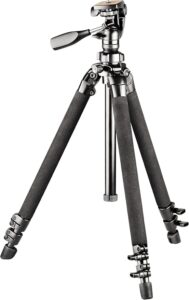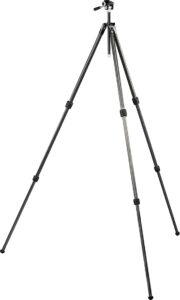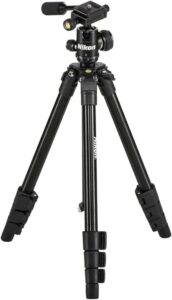Are you looking for the best binoculars tripod but having difficulty finding the right product for your needs? Look no further. This guide will explore some of the best tripods for binoculars across various budgets and use cases and help you find the ideal model for your needs.
Getting a tripod for your binoculars is important if you want to enhance your glassing comfort. A tripod not only allows for hands-free viewing but also reduces fatigue while increasing viewing accuracy, especially at higher magnifications.
Additionally, a reliable tripod minimizes shake, providing a stable and consistent view that makes spotting fine details easier.
However, selecting the best tripod for binoculars is no mean feat. It involves considering several important factors, such as stability, weight, adjustability, and compatibility with different binoculars.
High-end options are often crafted from lightweight and durable materials like carbon fiber or aluminum that balance portability and sturdiness.
Best Tripods for Binoculars
If you are into birdwatching, stargazing, or any outdoor activity where stability and long periods of observation are essential, below are the best tripods for binoculars for you to choose from. Let’s take a look.
1) Vortex Optics High Country II Tripod Kit
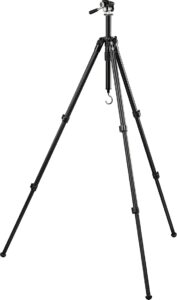
Specifications
- Material: Aluminum
- Item Weight: 4lbs
- Maximum Load: 22 Pounds
- Maximum Height: 62.5 Inches
- Head Type: Pan Head
The Vortex Optics High Country II Tripod Kit is the best tripod for binoculars. It has a capacity that is impressive for its size and weight, making it an ideal option for outdoor enthusiasts, photographers, and hunters looking for a lightweight yet sturdy tripod.
With its lightweight construction, the tripod is easy to transport over rough terrain and ideal for long hikes and backcountry excursions. The aluminum construction feels solid and dependable, giving you confidence that it can withstand the elements.
Furthermore, the tripod extends up to 62.5 inches, allowing you to adjust it to a comfortable height. After use, it folds down into a compact 18-inch, making it easy to stow in a backpack. Besides, the three-leg sections with twist-lock mechanisms are quick and easy to deploy, and the nonslip rubber feet provide a stable base even on uneven surfaces.
The Vortex Optics High Country II also includes a smooth, easy-to-use ball head that offers full 360-degree rotation and a 90-degree tilt, enabling precise adjustments for various applications.
The included quick-release plate makes it convenient to mount and remove your equipment quickly. Moreover, the ball head features a locking mechanism to secure the camera or scope in place, which is especially valuable in windy conditions or on rough ground.
Pros
- Decent load capacity
- Lightweight, compact, and portable
- Easy to set up
- Durable aluminum construction
Cons
- Stiff ball head
Get it on Amazon, Optics Planet, or Brownells
2) LCNCY Binocular and Spotting Scope Tripod Stand
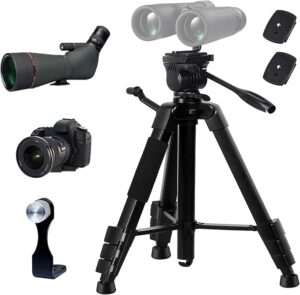
Specifications
- Material: Aluminum
- Item Weight: 2.2 lbs
- Maximum Load: 11 Pounds
- Maximum Height: 60 Inches
- Head Type: Universal Head
The LCNCY Binocular and Spotting Scope Tripod Stand is a highly reliable and well-designed piece of equipment for outdoor enthusiasts, bird watchers, and stargazers alike. For the price, this tripod is an excellent investment, combining stability, ease of use, and thoughtful design.
The selling point of this tripod is its construction quality. It has a durable, lightweight aluminum alloy construction that provides a stable base while remaining portable enough for extended outings. Furthermore, the legs extend smoothly and lock securely, allowing you to adjust the height to your desired level without hassle.
For added convenience, this tripod features a quick-release plate that makes it easy to attach and detach your binoculars or spotting scope. Additionally, the head allows for 360-degree rotation and tilting, enabling a wide range of motion that enhances versatility in various terrains and viewing angles.
What’s more, this tripod has wide compatibility with optical devices. It comes with a universal adapter that fits most binoculars and spotting scopes, ensuring you won’t need additional attachments. The stability is also impressive as it holds heavy scopes steadily, even in windy conditions, without compromising image clarity.
Pros
- Anti-slip rubber feet, which keep the stand grounded on uneven surfaces
- Lightweight design
- Wide compatibility with optical devices
- Reasonably affordable
Cons
- Poor tiltability
Get it on Amazon
3) Vanguard VEO 2 PRO 233CO Carbon Fiber Tripod
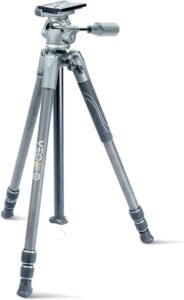
Specifications
- Legs: 23 mm, 3-section carbon fiber legs
- Folded height: 22″
- Extended height: 57.5″
- Weight: 3.2 pounds
- Max. load capacity: 8.8 pounds
Vanguard has a reputation for making quality and cost-effective optics accessories and the VEO 2 PRO 233CO Carbon Fiber Tripod is not any different. It is an impressive, well-engineered piece of equipment designed to cater to both beginner and professional photographers.
Weighing only 3.2 pounds, the tripod is exceptionally lightweight without compromising on strength or stability. Its folded height of 22″ extends up to 57.5 inches, making it ideal for a variety of shooting perspectives, whether you’re shooting landscapes or portraits. Furthermore, the three-section legs, secured by twist locks, are quick to set up and adjust, allowing for seamless transitions between shots.
With a load capacity of 8.8 pounds, the VEO 2 PRO 233CO comfortably supports most binoculars, making it versatile for users with a range of gear. The included Arca-compatible ball head further enhances the user experience by providing smooth 360-degree panning and secure locking for precise framing.

